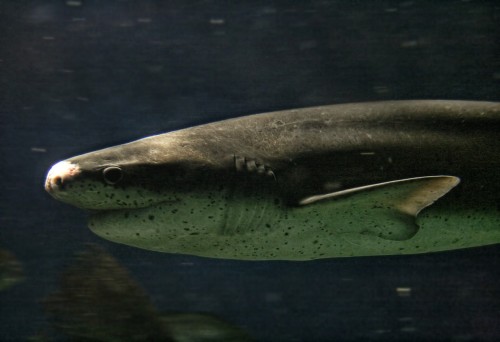
Guest post by Mike Bear
The San Diego-based non-profit Ocean Sanctuaries was founded in 2014 to create and provide support for marine citizen science projects. The Sevengill Shark Identification Project was one of its first citizen science projects, begun in 2010 in response to anecdotal evidence that divers were seeing increasing numbers Sevengill sharks off the coast of San Diego. This made the species an ideal candidate for a long-term 5-10 year) population study.
The Sevengill shark (Notorynchus cepedianus), named for having seven gill slits on either side of its body, as opposed to the normal 5 gills, reaches lengths of 3 m with an average length of 1.5 m. They weigh up to 107 kg and are known to live as long as 49 years.1
Sevengills are usually found over the continental shelves in shallow waters off the West Coast of the United States, Australia, New Zealand and South Africa. They are often sighted close inshore, in bays and estuaries, with larger individuals having ranges that include deeper waters offshore and deep channels in bays to 570 m. They are seen usually cruising slowly near the bottom, even in waters as shallow as a meter, and sometimes at the surface. Sevengills are known to hunt in packs and can attack at great speeds when pursuing prey. They prefer rocky bottom habitats although they commonly occur over sandy and muddy bottoms as well.1
Although this shark has a wide range, it is subject to intense fishing pressure as a result of being restricted to inshore waters. Currently the World Conservation Union (IUCN) lists the Sevengill shark as “Data Deficient”. Data is lacking in most regions, making it difficult to determine the overall status of this species. However, it is currently assessed as “Near Threatened” in the eastern Pacific Ocean.”1
This study has now expanded to Cape Town, South Africa, as part of a citizen science partnership with the Two Oceans Aquarium in Cape Town, as part of an effort to include citizen science photographic documentation from False Bay, South Africa, another area where this species is commonly seen.2
How does this citizen science project work? Divers do their normal dive and if they observe a Sevengill shark and can take a photograph of the lateral view of the head and gill area without endangering their safety, they do so and then upload that photograph to the ‘Wildbook’ database at Sevengill Shark Sightings.
‘Wildbook’ is an open source software framework designed to support collaborative mark-recapture, molecular ecology, and social ecology studies, especially where citizen science data needs to be incorporated and managed. It was designed by information architect Jason Holmberg, who was co-author on a 2005 paper published in the Journal of Applied Ecology describing how pattern-matching algorithms used in astronomy could be adapted for computer-aided identification of whale sharks (Rhincodon typus).3
Contained within Wildbook are two pattern recognition algorithms, which scan submitted photographs and analyze the black freckling pattern seen around the eyes and gill area of this species (see photograph below), which identify individuals in much the same way as a fingerprint does. In this way, photographs submitted over time in a single location can determine if and which sharks are returning to the same location from year-to-year.4

Data from the San Diego and Cape Town databases are still being analyzed, and since this is a long-term study, final results may not be ready for another few years.
However, ours and other projects are already beginning to provide some interesting insights on citizen science methods. I recently compared the methodologies of 3 marine citizen science projects: Reef.org, Reef Check California and Ocean Sanctuaries’ Sevengill Shark Identification Project in an article titled ‘Perspectives on Marine Citizen Science,’ published in which I contributed to the March 2016 ‘Science Citizenship’ issue of the Journal of Microbiology and Biology Education. I placed emphasis on the role played by the recent miniaturization of video cameras (such as the Go Pro) used to collect data for marine citizen science projects.5
High definition photographic data collection methods are replacing the older diver identification method, because they are more accurate for species identification. The older method relied on a diver’s ability to identify various species from memory, which leaves more room for error. The Sevengill project uses high definition photography which provides much more detail about the shark sightings.
Citizen science has come a long way since its inception and is coming into its own as a scientific discipline, using armies of citizen scientists to gather and analyze data under the mentorship of professional scientists which, in many cases, are just as reliable as data gathered by conventional means.6
References
- Marinebio.org: Sevengill shark
- Two Oceans Aquarium Blog
- Holmberg J, Norman B & Arzoumanian Z (2005), Journal of Applied Ecology, An Astronomical Pattern-Matching Algorithm for Computer-Aided Identification of Whale Sharks Rhincodon typus. Abstract
- Sevengill Shark Project, Methodology
- Michael Bear, ‘Perspectives in Marine Citizen Science, ’Journal of Microbiology and Biology Education/Vol. 17: March, 2016 Article
- Acoustic Telemetry Validates a Citizen Science Approach for Monitoring Sharks on Coral Reefs: PLOS ONE

